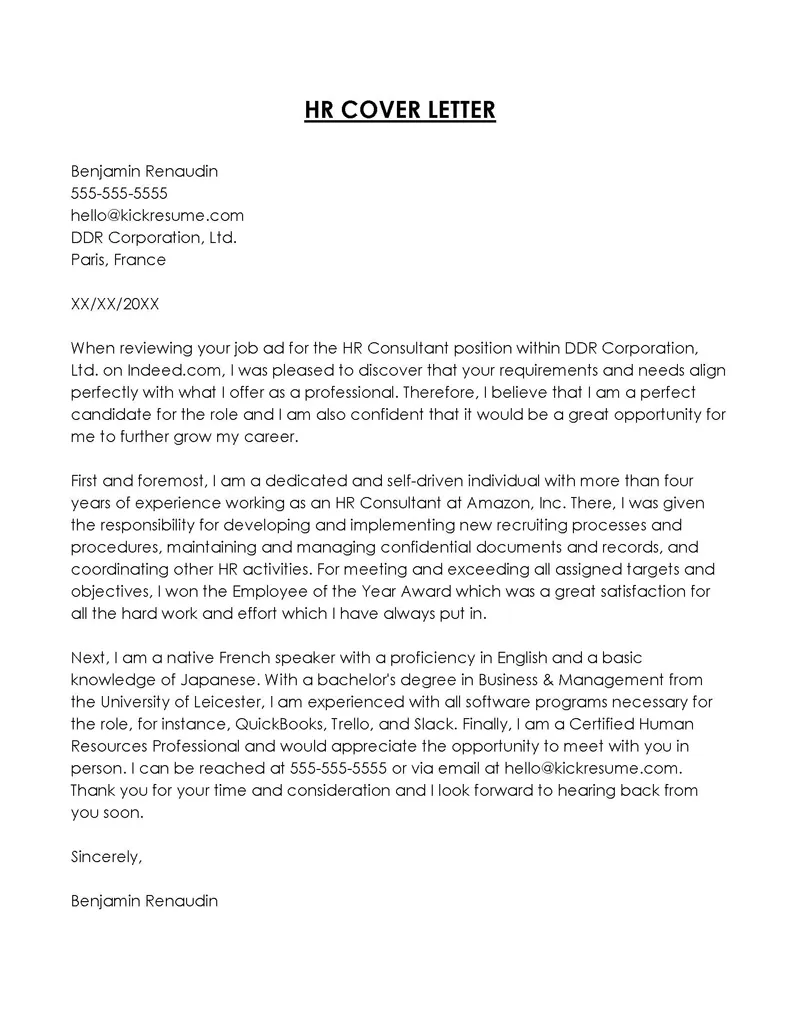Understanding the Purpose of an HR Cover Letter
A cover letter serves as your initial introduction to a potential employer, specifically in the realm of Human Resources. It’s your chance to make a compelling first impression and distinguish yourself from other applicants. Unlike a resume, which provides a factual account of your experience and skills, a cover letter allows you to demonstrate your personality, enthusiasm, and genuine interest in the HR position and the company. It’s your platform to connect with the hiring manager on a more personal level, showcasing why you’re a perfect fit for the role and the company culture. The cover letter allows you to expand on the information presented in your resume and tailor it specifically to the job description, emphasizing the skills and experiences that are most relevant to the position. Effectively addressing the cover letter to HR professionals will assist you in getting hired.
Why a Cover Letter Matters to HR
In the HR field, attention to detail, clear communication, and a professional demeanor are paramount. Your cover letter provides a direct assessment of these qualities. HR professionals often use the cover letter as an initial screening tool to evaluate an applicant’s writing skills, grammar, and overall professionalism. A well-crafted cover letter demonstrates your ability to communicate effectively, a skill critical for HR roles involving employee relations, policy development, and communication with stakeholders. Additionally, it shows your initiative and willingness to go the extra mile, which HR managers highly value. A cover letter lets you articulate your passion for human resources, highlighting your understanding of HR principles and your commitment to the company’s success. This demonstrates your interest beyond just the job; it indicates your genuine engagement with the company and the HR field.
Highlighting Your Key Skills
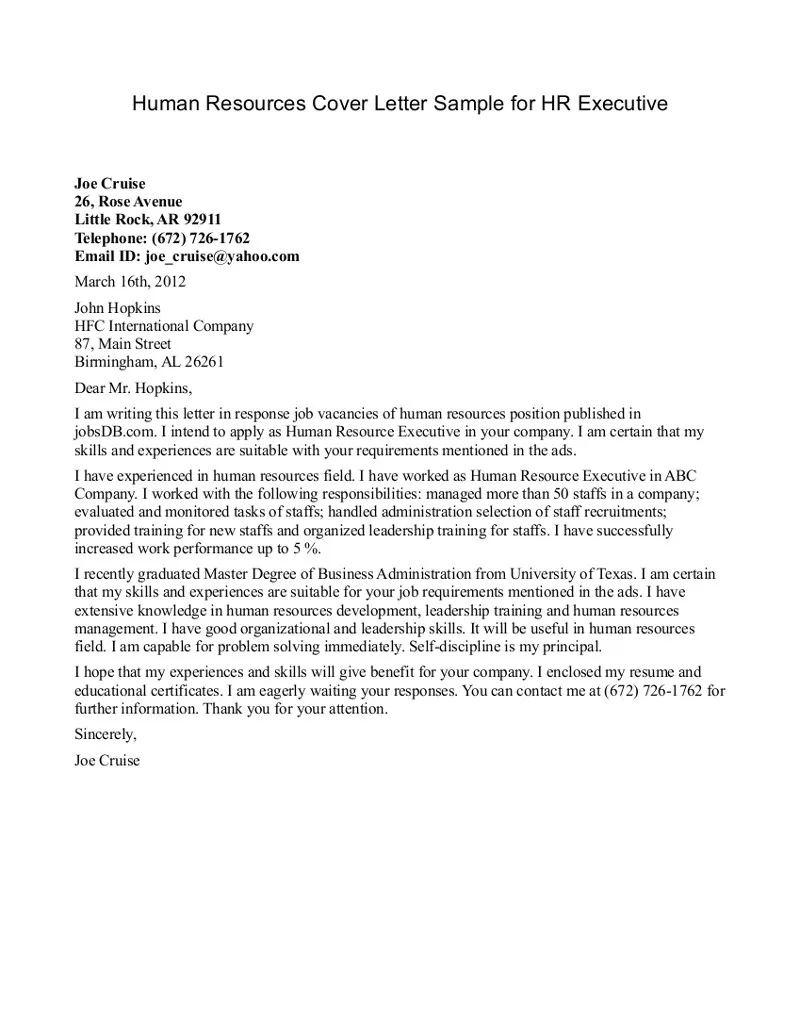
Your cover letter is where you strategically spotlight the skills most relevant to the HR role you’re applying for. Go beyond simply listing your qualifications; provide specific examples of how you’ve utilized these skills in the past. Tailor your skills to match the requirements listed in the job description, ensuring that your cover letter resonates with the hiring manager’s needs. If the job requires strong communication skills, provide instances where you’ve successfully mediated conflicts, delivered presentations, or crafted effective internal communications. For positions emphasizing organizational skills, highlight projects where you’ve managed multiple tasks simultaneously or improved HR processes. For example, if the role involves recruitment, explain how you’ve sourced candidates, conducted interviews, or streamlined the hiring process. By highlighting your key skills with concrete examples, you demonstrate your competence and make a convincing case for why you’re the ideal candidate.
Formatting Your HR Cover Letter
The formatting of your HR cover letter is as essential as its content, reflecting your professionalism and attention to detail. A well-formatted letter is easy to read and presents a polished image. Maintain a consistent font style and size throughout the document. Choose a font that is clean and professional, such as Times New Roman, Arial, or Calibri, and ensure that the font size is readable (typically 11 or 12 points). Use single spacing within paragraphs and double spacing between paragraphs to improve readability. Ensure a clear layout with adequate margins on all sides, preventing the document from appearing cramped or cluttered. Proper formatting is crucial in creating a positive first impression. Correct formatting displays organizational skills.
Contact Information and Date
Begin your cover letter with your contact information, including your name, address, phone number, and email address. This information should be clearly visible at the top of the letter. Follow this with the date, aligned to the left or right. This sets the tone for your professionalism and ensures the hiring manager can easily contact you. Place your contact information on the top, ensuring that the hiring manager can immediately locate how to reach you if they choose to follow up with you. The date indicates when the cover letter was written and submitted, helping the employer keep track of the application’s timeline. Keeping the date concise ensures that the cover letter remains current.
Addressing the Hiring Manager
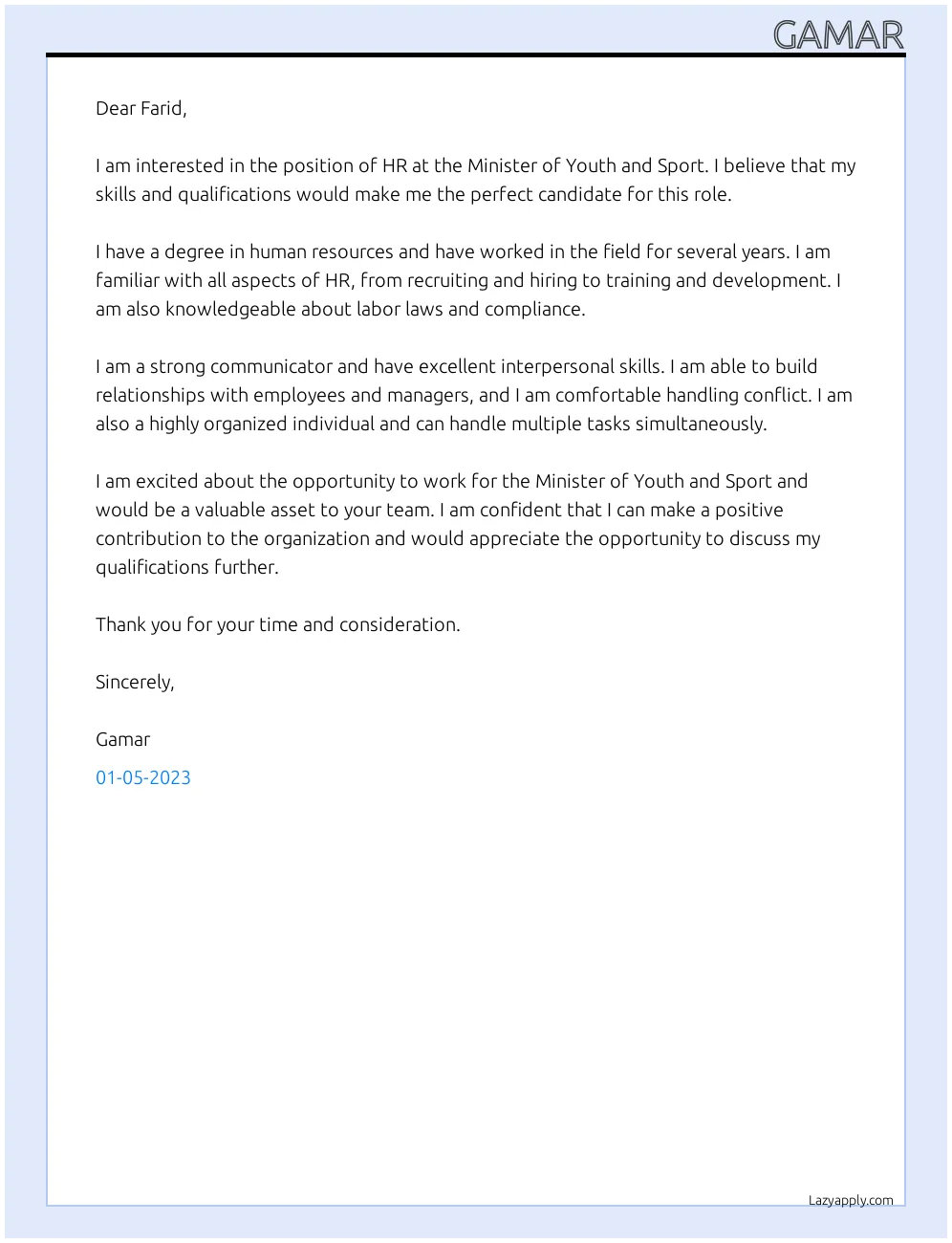
Always address the hiring manager by name. This shows that you’ve taken the time to research the company and the specific role, demonstrating a genuine interest in the position. If possible, find out the name of the hiring manager through the job posting, the company website, or LinkedIn. Using the person’s name immediately establishes a more personal connection. Avoid generic greetings like “To Whom It May Concern.” If you cannot find a specific name, you can use a professional title, such as “Dear Hiring Manager.” Personalizing your cover letter will make the reader feel more respected.
Opening Paragraph
Your opening paragraph should immediately grab the hiring manager’s attention and establish your interest in the HR position. State the specific job title you’re applying for and where you found the job posting. Briefly highlight your most relevant skills and experiences that align with the job requirements. Clearly state the purpose of your letter and convey your enthusiasm for the role. A strong opening paragraph sets the stage for the rest of your letter. It should be concise, compelling, and designed to encourage the hiring manager to continue reading. It shows confidence and provides a great start. For example: “I am writing to express my keen interest in the HR Manager position at [Company Name], as advertised on [Platform]. With five years of experience in talent acquisition and employee relations, I am confident I can contribute to your team’s success.”
Body Paragraphs for HR Positions
The body paragraphs of your cover letter are your chance to demonstrate your skills and experiences in detail, aligning them with the specific requirements of the HR position. Focus on showcasing your accomplishments rather than just listing your responsibilities. Provide quantifiable results whenever possible, such as numbers or percentages, to demonstrate the impact of your work. Tailor each paragraph to match the job description, emphasizing the skills and experiences that are most relevant to the role. Use the STAR method (Situation, Task, Action, Result) to structure your responses, providing context, detailing the tasks you undertook, explaining the actions you took, and highlighting the positive results achieved. For example: “In my previous role at [Company Name], I reduced employee turnover by 15% through the implementation of a new employee engagement program, which involved conducting regular feedback sessions and implementing recognition initiatives.”
Showcasing Relevant Experience
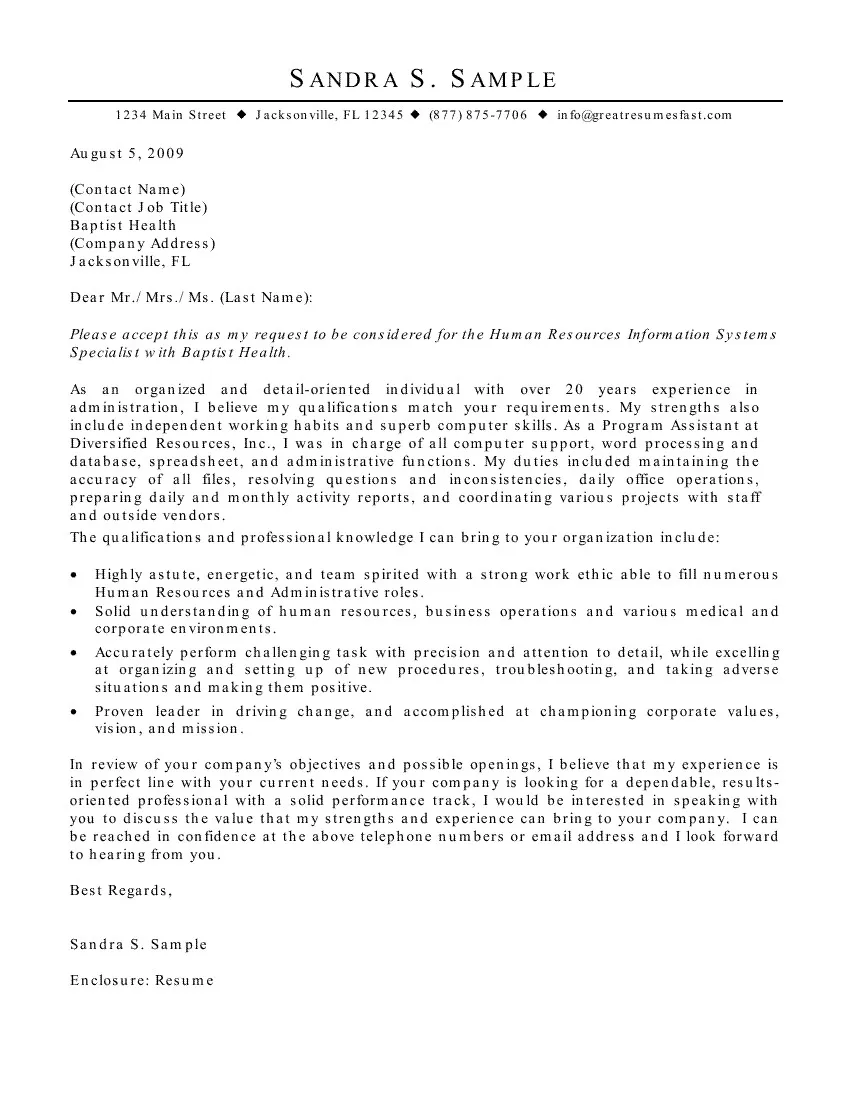
When showcasing your experience, select the most relevant aspects of your professional background to highlight. Prioritize experiences that align with the specific duties and responsibilities outlined in the job description. If the HR position involves recruitment, emphasize your experience in sourcing candidates, conducting interviews, and managing the onboarding process. If the role focuses on employee relations, highlight your experience in resolving conflicts, mediating disputes, and fostering a positive work environment. Use the STAR method to provide context, explain the actions you took, and detail the positive outcomes. This will help the hiring manager better understand your capabilities. Showcasing your experience effectively will help you stand out from the competition.
Quantifying Achievements in HR
Quantifying your achievements is a powerful way to demonstrate your impact and effectiveness in HR. Use numbers, percentages, and data to showcase the results you’ve achieved in your previous roles. Instead of simply stating that you improved employee satisfaction, specify by how much (e.g., “Increased employee satisfaction scores by 20% through implementing new wellness programs”). If you reduced employee turnover, state the percentage reduction achieved (e.g., “Decreased employee turnover by 10% within one year through enhanced retention strategies”). By providing concrete evidence of your accomplishments, you make a strong case for your abilities and demonstrate the value you can bring to the organization. This approach will help the hiring manager recognize your ability to achieve and surpass targets.
Demonstrating Skills and Abilities
In addition to highlighting your experience and achievements, you need to clearly demonstrate the skills and abilities that are essential for the HR position. These skills can be categorized into hard skills (technical abilities) and soft skills (interpersonal qualities). Highlight the hard skills by mentioning your proficiency in HR software, your knowledge of employment laws, or your expertise in specific HR functions. Demonstrate your soft skills by providing examples of your communication skills, problem-solving abilities, and teamwork skills. If the job requires strong communication skills, mention instances where you effectively communicated with employees, mediated conflicts, or delivered presentations. If the role demands strong problem-solving abilities, describe how you’ve successfully resolved complex issues or implemented effective solutions. By effectively showcasing these skills, you show that you have the necessary qualities and that you’re a great fit for the HR position.
Closing Your HR Cover Letter
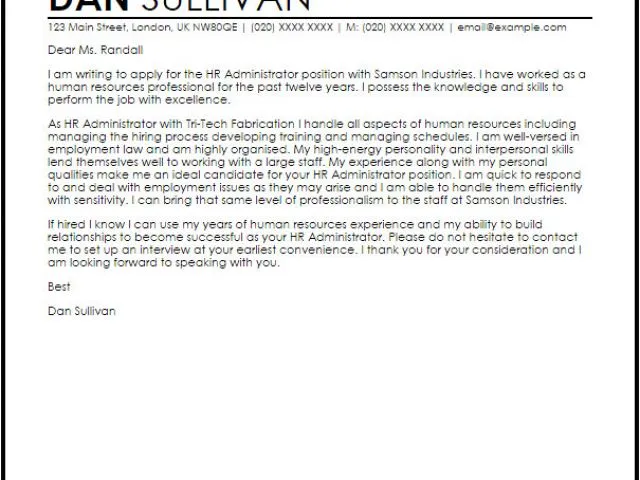
Your closing paragraph should be strong and memorable, leaving the hiring manager with a positive impression. Reiterate your interest in the position and the company, and express your enthusiasm for the opportunity. Summarize your key qualifications and reiterate how you believe you can contribute to the organization’s success. Close with a call to action, such as requesting an interview and providing your contact information. Proofread the entire letter to ensure there are no typos or grammatical errors. A well-crafted closing paragraph reinforces your interest and sets the stage for the next step in the hiring process.
Expressing Enthusiasm and Interest
End your cover letter by expressing your enthusiasm for the HR position and the company. Reiterate your genuine interest in the role and mention what specifically attracts you to the organization. Show that you understand the company’s mission, values, and culture, and how your skills and experiences align with them. For example, you could state: “I am particularly excited about the opportunity to contribute to [Company Name]’s commitment to employee development and engagement. I am confident that my skills and experience in talent acquisition and employee relations make me an ideal fit for this role.” Expressing enthusiasm will give the hiring manager a great impression and will want to call you in for an interview.
Call to Action
Your closing paragraph should always include a clear call to action. This is your opportunity to directly ask for an interview and to make it easy for the hiring manager to take the next step. State your availability for an interview and express your willingness to discuss your qualifications further. Provide your contact information again for easy reference. For example: “I am available for an interview at your earliest convenience and would welcome the opportunity to discuss my qualifications in detail. Thank you for your time and consideration. You can reach me at [phone number] or [email address].” This shows that you are eager and that you are prepared for the hiring manager to reach out.
Proofreading and Editing
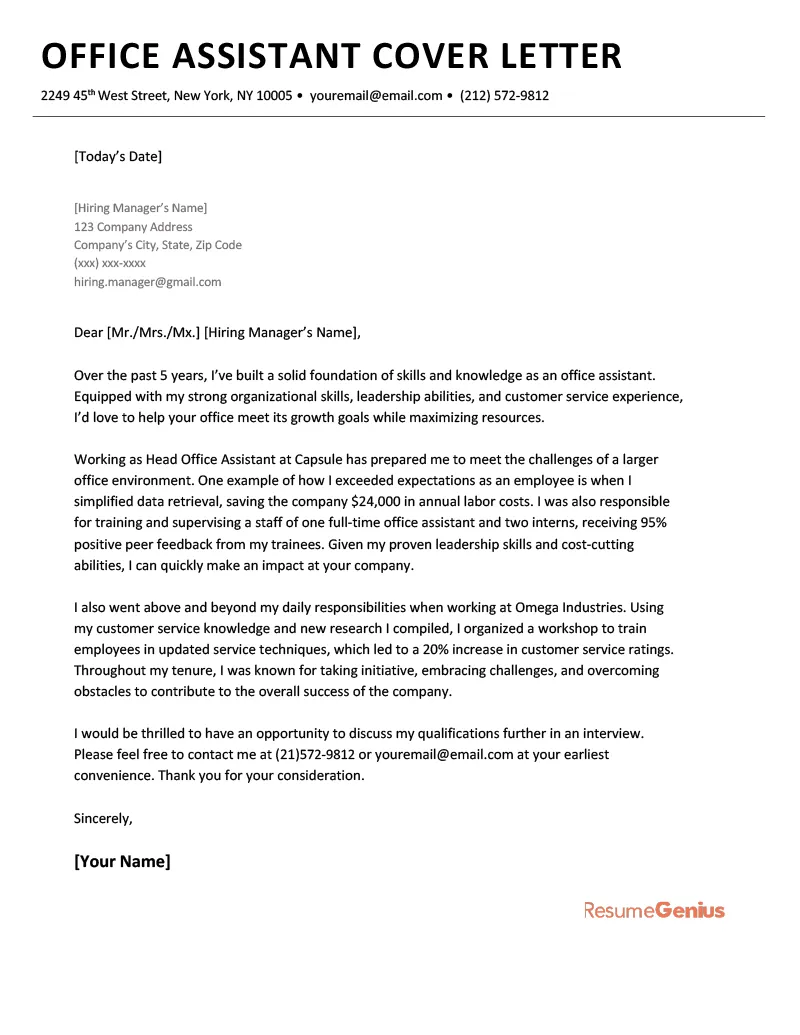
Thorough proofreading and editing are crucial steps in ensuring that your cover letter is polished, professional, and free of errors. Proofread your letter multiple times, paying close attention to grammar, spelling, punctuation, and sentence structure. Read the letter aloud to catch any awkward phrasing or inconsistencies. Consider using grammar and spell-check tools, but don’t rely on them entirely; they may not catch all errors. Ideally, have a friend, colleague, or mentor review your cover letter for feedback. They can provide a fresh perspective and identify any errors or areas for improvement that you may have missed. This will ensure a more refined and error-free cover letter.
Common Mistakes to Avoid
Avoid common mistakes that can damage your chances of getting an interview. Do not use generic, impersonal language. Instead, tailor your cover letter to the specific job and the company. Do not simply rehash your resume. Your cover letter should provide additional information and demonstrate your personality and enthusiasm. Avoid using jargon or overly technical language. Instead, use clear, concise language that is easy to understand. Do not make any typos or grammatical errors. Thoroughly proofread your letter before submitting it. Ensure that you highlight your enthusiasm, express interest, and make the cover letter personal. Following these steps will make your cover letter much more appealing.
Ensuring Accuracy
Accuracy is critical. Verify all the information in your cover letter, including the hiring manager’s name, the company name, and the job title. Double-check your contact information to ensure it’s correct. Ensure that your letter aligns with the job description, highlighting the skills and experiences most relevant to the position. Finally, always customize your cover letter for each job application. Sending a generic cover letter to multiple companies is a surefire way to appear uninterested and unprofessional. Take the time to tailor your cover letter to the specific needs of each role and company, and you’ll significantly increase your chances of success.
